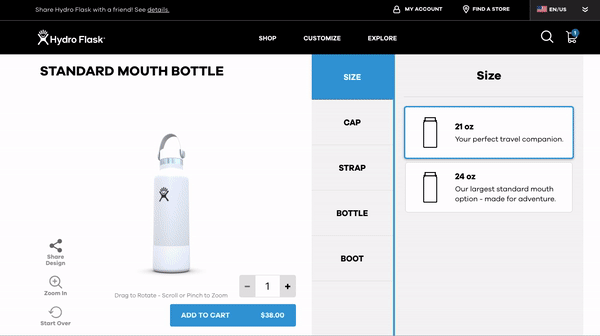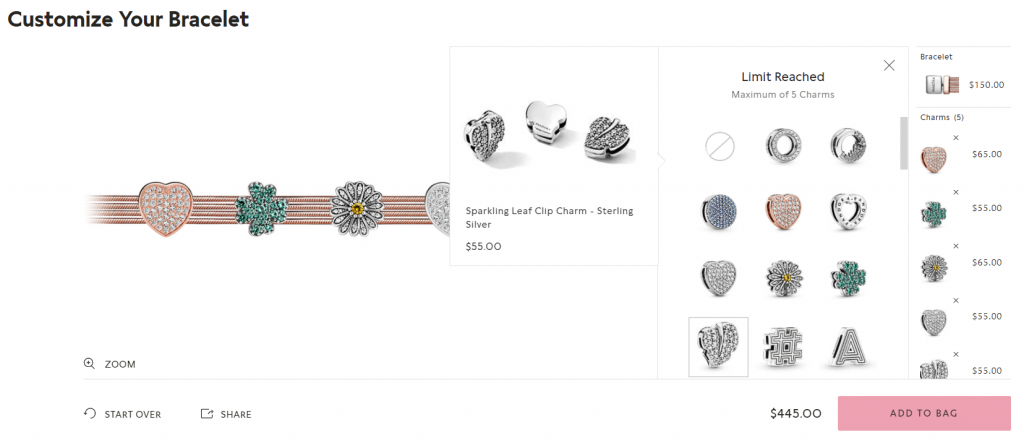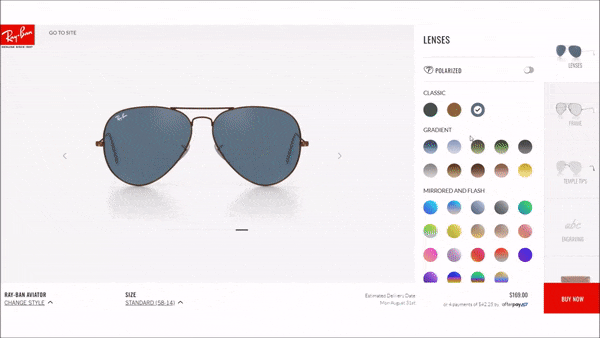oxygen domain was triggered too early. This is usually an indicator for some code in the plugin or theme running too early. Translations should be loaded at the init action or later. Please see Debugging in WordPress for more information. (This message was added in version 6.7.0.) in /var/www/wp-includes/functions.php on line 6121
Mass customization defines a satisfying customer experience. In short, that makes them happy – and that drives sales.
According to recent findings, 83 percent of customers today expect personalization of products or services they can achieve within moments or hours. For the experience of “co-creating” by choosing from drop menus to fully customizing an item, consumers are willing to pay a premium of over 25 percent.
To dominate this evolving product ecosystem, top mass customization companies need to align their business to the needs and wants of their customers.
Mass customization is the application of specific standards and scale economies so customers can mix and match configurations to come up with a custom-made product. While aiming to meet the requirements of customers, you need to keep in mind affordability while making a profit. Below are some of the benefits of mass customization:
Giving consumers a sense of control when they buy products or tap your company’s services can help your brand understand what they need and want. When you can meet their demands, you can optimize your supply chain and production to minimize excess inventory.
With easy access to more information and readily available alternative brands, a survey revealed that 91 percent of today’s consumers are more likely to buy from brands that recognize and offer relevant recommendations to them.
With brand loyalty, 60 percent of customers purchase more frequently from trusted brands, and 50 percent of these loyal customers spend more on their purchases. Customization of products and better customer experience allows you to charge more. Mass customization allows you to offer a range of options that make products more appealing to a more significant number of people, leading to an increase in sales.
Understanding the importance of customization is essential, but you need to carefully choose the best approach to deliver the best value to your target market. By putting your customer in the driver’s seat during the buying process, you gain a competitive advantage over other brands that cannot provide the same experience.
The concept of mass customization is nothing new. More than 20 years ago, Joseph Pine and James Gilmore outlined the different faces of mass customization:
As the name suggests, this kind of mass customization involves creating a product in collaboration with clients. You will talk to your customers, find out their needs, help them narrow down options, and create products based on the information you have obtained from your customers.
In adaptive mass customization, you mass-produce standardized products and give consumers the features they can add to make the item unique from home or the office. As a result, you end up with a customized product with a reasonable price tag, making this type of customization ideal for online sellers.
Cosmetic customization boils down to the packaging of products for different customers. This does not translate to creating hundreds of variants of your goods, but to differentiating your offerings by tweaking packaging, pricing, quantity, marketing approach, personalization, or other variables.
For transparent customization, you need to analyze customer behaviors to supply and customize your products without informing customers. The products constantly evolve depending on the needs of customers.
Mass customization approaches vary, but they all require extra effort to satisfy the customers’ needs. So, what does the extra work involve if you want to succeed in mass customization?
With mass customization, you deviate from the cookie-cutter approach when selling your products and services. You use it to stand out from the rest, making the buying experiential for your customers. Below are some mass customization examples:
Hydro Flask traces its roots in Bend, OR. The vacuum insulated steel water bottles were created by a couple who wanted to keep their cold drinks cold. It’s the widely-used water bottle among millennials, Generation Z, and Generation Alpha. It’s a high-quality bottle with tons of personalization options. Priced between $30 and $60, you can choose your color, sizes, boots, lids, straps, and limited-edition customizations when you visit the online shop.

Via Hydro Flask
After launching its line of signature charm bracelets more than 20 years ago, the Danish jewelry brand Pandora became a household name. Today, its products are being sold in more than 100 countries with a team of more than 26,000 people.
It is an affordable brand with bracelets that start below $50 charmed that market dominated by luxury brands. The success of the brand did not happen overnight but consumers fell in love with Pandora’s collectible bracelets and collectible charms. The company’s bracelets can be considered one of the best mass customization examples that hit the bull’s eye of success. Today the brand continues to count on jewelry as self-expression to attract the younger sector of the market.

Via Pandora
In the 1990s, this brand was in trouble. The quality of the product was poor and the styles of its shades did not appeal to the market. It retooled, offered personalization, and was able to revitalize the brand. Visit its website, and you’ll be able to pick a frame, choose the lenses, select temple tips, and even add engraving to your shades.
For its Aviator Class, Ray-Ban offers 37 styles, 149 lenses, and 290 colors. You can create your very own unique combination, and they will make it for you.

Via Ray-Ban
As demonstrated by these brands, it is no easy task, but mass customization can be achieved.
Mass customization opens gates of opportunities for businesses to improve cash flow. In its most basic form, you produce a customized product for a specific customer with the efficiency one can expect from mass production.
There are three areas of focus to achieve successful mass customization. First, identify the customization opportunities that deliver good value to customers. Second, determine a cost structure to manufacture the products while remaining profitable. Third, assist customers in building solutions to address their needs.
A good balance of agile expertise, process, and technologies is needed to hit the mark. Some of the key success factors and technologies that can drive mass customization include the following:
While the benefits of mass customization are easy to list down, not all mass customization companies succeed. Here are some mass customization ideas to keep in mind when implementing the model:
ConfigureID has been in the business of helping brands connect with customers, making them happy co-creators of products and services. Our solution has the following features that will be essential in achieving your mass customization:
You will have access to an easy-to-use content management system (CMS) that will allow you to set up customizable products to showcase on your ecommerce site. You can also set up sophisticated configuration logic to ensure only valid combinations are allowed.
You can show off your products using high-quality 2D images or 3D models. Your customers will be able to interact with these to view the products from different angles.
Engage and convert more shoppers with our best-in-class UI. You can also customize it to meet your brand’s exact needs.
As product specs are updated you can easily incorporate discounts or upcharges as necessary. In turn, customers will see the appropriate adjustments to the price of the item they are buying.
If you sell in different countries, you will have localization options for different currencies and languages.
Mass customization is a must if you want to stand out from the rest. Empower consumers and create a truly personalized customer experience for them.
Request a demo now to learn more about what ConfigureID can offer your brand and your customers.